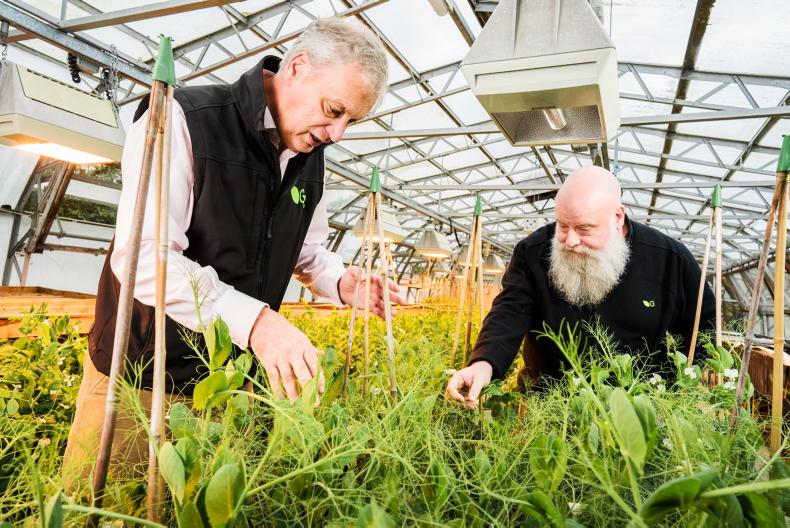A wider range of combinable legumes should be available for Irish farmers to grow in the future according to Dr Sheila Alves of Teagasc.
Research is ongoing into the potential for alternative legume crops, other than peas and beans, to be grown in the Irish climate.
The goal is to increase the production of indigenous protein crops to between 120,000t and 140,000t by 2030.
Strong yield potential, existing processing facilities and multiple end uses are helpful in developing non-feed added value opportunities for leguminous crops.
Higher potential
Narrow-leaf (blue) lupins have been shown to have a higher yield potential in Ireland than anywhere else in the European Union. The same is true for beans.
However, the issue with lupins until now has been the very late maturity of the lupins, if they mature at all. This is now being addressed through the evaluation of early-maturing varieties.
Teagasc currently has seven varieties under trial, with the addition of rhizobium, differing seeding rates and row spacing also being analysed.
Lentils were also singled out as having potential in Ireland. Two varieties have been bred for the northern European climate and they are in their first year of field trials.
Initial research indicates that they appear to be suited to the Irish climate and also possess some tolerance to drought, as do lupins.
Inter-cropping
The potential of inter-cropping was also discussed at Crops and Cover Crops Cultivations last week.
Trial plots at Oak Park showed a pea and bean inter-crop with differing proportions of each crop. This helps to avoid lodging, as the peas cling to the upright beans, with research showing that peas can continue to stand for four weeks longer at harvest time.
A greater total yield can be achieved through this inter-cropping method than by growing a pea or bean crop separately.
The current focus is on maximising the percentage of peas in this mix due to its excellent protein profile, but this can be changed to suit different situations.

White lupins bean/pea combicrop blue lupins.
There may be concerns among farmers about the peas and beans maturing at different times and also in separating the two crops post-harvest if required.
However, Dr Alves explained that they are using late maturing pea varieties and early maturing bean varieties to ensure that they are ready for harvest at the same time.
The dry separation method used by Teagasc has also proved to be a quick and simple way to separate the two legumes post-harvest.
A wider range of combinable legumes should be available for Irish farmers to grow in the future according to Dr Sheila Alves of Teagasc.
Research is ongoing into the potential for alternative legume crops, other than peas and beans, to be grown in the Irish climate.
The goal is to increase the production of indigenous protein crops to between 120,000t and 140,000t by 2030.
Strong yield potential, existing processing facilities and multiple end uses are helpful in developing non-feed added value opportunities for leguminous crops.
Higher potential
Narrow-leaf (blue) lupins have been shown to have a higher yield potential in Ireland than anywhere else in the European Union. The same is true for beans.
However, the issue with lupins until now has been the very late maturity of the lupins, if they mature at all. This is now being addressed through the evaluation of early-maturing varieties.
Teagasc currently has seven varieties under trial, with the addition of rhizobium, differing seeding rates and row spacing also being analysed.
Lentils were also singled out as having potential in Ireland. Two varieties have been bred for the northern European climate and they are in their first year of field trials.
Initial research indicates that they appear to be suited to the Irish climate and also possess some tolerance to drought, as do lupins.
Inter-cropping
The potential of inter-cropping was also discussed at Crops and Cover Crops Cultivations last week.
Trial plots at Oak Park showed a pea and bean inter-crop with differing proportions of each crop. This helps to avoid lodging, as the peas cling to the upright beans, with research showing that peas can continue to stand for four weeks longer at harvest time.
A greater total yield can be achieved through this inter-cropping method than by growing a pea or bean crop separately.
The current focus is on maximising the percentage of peas in this mix due to its excellent protein profile, but this can be changed to suit different situations.

White lupins bean/pea combicrop blue lupins.
There may be concerns among farmers about the peas and beans maturing at different times and also in separating the two crops post-harvest if required.
However, Dr Alves explained that they are using late maturing pea varieties and early maturing bean varieties to ensure that they are ready for harvest at the same time.
The dry separation method used by Teagasc has also proved to be a quick and simple way to separate the two legumes post-harvest.











SHARING OPTIONS